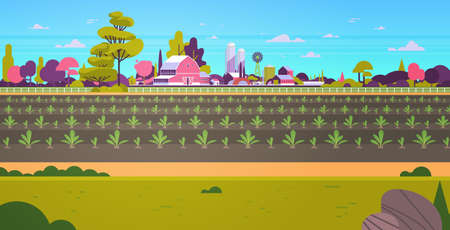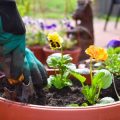1. Designing a Productive and Aesthetic Front Yard
Growing vegetables in your front yard doesn’t mean sacrificing style or curb appeal. In fact, with thoughtful planning, you can turn your front yard into a beautiful, productive space that both you and your neighbors will love. The key is to blend the principles of traditional landscape design with edible gardening elements.
Layout: Plan for Balance and Function
Start by sketching out your front yard’s layout. Consider how people move through the space—both visually and physically. Use pathways to guide the eye and foot traffic, and create clear zones for different types of plants. Raised beds, containers, or bordered plots help define areas while keeping things organized and neat.
Tips for a Balanced Layout:
| Design Element | Purpose | Example |
|---|---|---|
| Symmetry | Adds structure and formality | Matching raised beds on each side of a walkway |
| Asymmetry | Feels more natural and relaxed | A curved path with staggered planting beds |
| Layers | Creates depth and interest | Tall trellised beans in back, medium kale in middle, low herbs in front |
Focal Points: Make Edibles Eye-Catching
A focal point draws attention and gives the garden a sense of purpose. You can use a colorful vegetable variety, an ornamental trellis with climbing cucumbers or peas, or even a decorative bench surrounded by edible plants. Choose something that stands out but also complements the rest of your garden design.
Integrating Vegetables with Flowers and Shrubs
The easiest way to make vegetables look like they belong in your front yard is to mix them with ornamental plants. Many veggies have their own charm—think rainbow chard’s vibrant stems or the bold leaves of artichokes. Pair these with flowering perennials, native shrubs, or low-maintenance ground covers.
Great Edible-Ornamental Combos:
| Vegetable | Ornamental Companion | Why It Works |
|---|---|---|
| Kale (purple or curly) | Lavender or Salvia | Contrasting textures and complementary colors |
| Tomatoes (in cages) | Dwarf sunflowers or marigolds | Adds brightness and attracts pollinators |
| Basil or Thai basil | Zinnias or petunias | Scented foliage pairs well with vibrant blooms |
By combining smart layout choices, attractive focal points, and harmonious plant pairings, you can grow vegetables in your front yard that are as beautiful as they are delicious.
2. Choosing the Right Vegetables for Your Climate and Style
When growing vegetables in your front yard, its important to pick varieties that not only grow well in your local climate but also look great as part of your landscape design. The right plants will blend beauty and function, giving you a space that’s both productive and eye-catching.
Match Vegetables to Your USDA Hardiness Zone
The USDA Plant Hardiness Zone Map helps gardeners across the U.S. choose plants that can survive their local winter temperatures. Before selecting vegetables, find out which zone youre in. This ensures your plants can thrive through the seasons.
| USDA Zone | Good Vegetable Choices |
|---|---|
| 3-5 (Cold) | Kale, Cabbage, Carrots, Beets, Peas |
| 6-7 (Moderate) | Lettuce, Chard, Tomatoes, Peppers, Green Beans |
| 8-10 (Warm) | Eggplant, Okra, Sweet Potatoes, Basil, Melons |
Select Visually Appealing Edible Plants
Vegetables can be just as beautiful as flowers when chosen thoughtfully. Look for plants with colorful leaves, interesting shapes, or vertical growth habits to add variety and structure to your front yard garden.
Examples of Decorative Edibles:
- Rainbow Chard: Bright stems in red, yellow, and orange make this leafy green a standout.
- Purple Basil: Deep purple leaves add contrast and fragrance.
- Red Lettuce: Adds texture and rich color to borders or containers.
- Dwarf Kale: Compact with curly leaves—great for edging paths.
- Artichokes: Their silvery foliage and dramatic flower buds make a bold statement.
Consider Plant Height and Growth Habit
Mix tall and short plants to create layers of interest. Place taller vegetables like tomatoes or trellised cucumbers toward the back or center of a bed, with shorter ones like lettuce or herbs along the edges. This creates visual balance while maximizing sunlight exposure.
Think Seasonally
Your front yard garden should look good year-round. Choose a mix of cool-season crops (like kale and spinach) and warm-season favorites (like zucchini and peppers) so there’s always something growing—and looking good—in your yard.
Seasonal Planting Ideas by Region:
| Region | Spring/Summer Picks | Fall/Winter Picks |
|---|---|---|
| Northeast & Midwest | TOMATOES, PEPPERS, ZUCCHINI | CABBAGE, KALE, RADISHES |
| Southeast & Gulf Coast | MELONS, OKRA, SWEET POTATOES | |
| Southwest & West Coast | BASIL, EGGPLANT, PEPPERS | BROCCOLI, SPINACH, ONIONS |
Selecting vegetables that suit both your climate and design taste is the first step toward creating a front yard thats as tasty as it is beautiful. Think beyond function—your edible garden can be the best-looking one on the block!

3. Soil Preparation and Raised Bed Installation
Before planting vegetables in your front yard, it’s essential to make sure your soil is healthy and well-suited for growing food. Most front yards weren’t originally designed with edible gardens in mind, so giving your soil some attention can make a big difference in how well your vegetables grow—and how beautiful your landscape looks.
Test Your Soil First
A soil test helps you understand what nutrients are present and what might be missing. You can pick up a simple soil test kit at most garden centers or contact your local county extension office for more detailed testing. Here’s what to check for:
| Soil Component | What It Tells You |
|---|---|
| pH Level | Whether your soil is acidic, neutral, or alkaline—most vegetables prefer a pH between 6.0 and 7.0. |
| Nitrogen (N) | Supports leafy growth; too little leads to pale leaves, too much causes excessive foliage with few fruits. |
| Phosphorus (P) | Helps with root development and flowering. |
| Potassium (K) | Boosts overall plant health and disease resistance. |
Amend Your Soil for Better Results
If the test shows your soil needs improvement, don’t worry—it’s easy to fix. Here are some common amendments:
- Compost: Adds organic matter and improves drainage and nutrient content.
- Lime: Raises pH if your soil is too acidic.
- Sulfur: Lowers pH if your soil is too alkaline.
- Organic fertilizers: Boost specific nutrients based on your test results.
Till the amendments into the top 6–8 inches of soil using a shovel or garden fork. This gives vegetable roots room to grow deep and strong.
Why Raised Beds Work Great in Front Yards
Raised beds are one of the easiest ways to grow vegetables while keeping your front yard tidy and attractive. They help define space, improve drainage, and reduce weed competition—all while looking neat and intentional as part of your landscape design.
Choosing the Right Spot
Your raised bed should get at least 6 hours of direct sunlight per day. Avoid placing it under large trees or in low spots where water collects after rain.
Materials That Look Good and Last Long
You can build raised beds from a variety of materials. Choose one that matches the style of your home while being safe for food crops:
| Material | Pros | Considerations |
|---|---|---|
| Cedar or Redwood | Naturally rot-resistant, attractive wood grain | More expensive than other woods |
| Pine (treated with linseed oil) | Budget-friendly, easy to find | Less durable unless treated naturally; avoid pressure-treated lumber for edibles |
| Recycled Composite Boards | No rot, long-lasting, clean look | Higher upfront cost; may not match all aesthetics |
| Cinder Blocks or Bricks | Durable, modern or rustic look depending on style | Heavier to install; edges can be sharp without caps |
Step-by-Step: Building a Simple Raised Bed
- Select a sunny location with good drainage.
- Create a rectangle layout using string or stakes—typical size is 4 ft wide by 8 ft long.
- Add edging material (wood boards, bricks, etc.) to form the sides—height should be at least 10–12 inches for vegetables like carrots or tomatoes.
- Add a layer of cardboard or newspaper on the ground inside the bed to block weeds.
- Fill with a mix of topsoil, compost, and organic matter (a good ratio is 60% topsoil, 30% compost, 10% other amendments).
- Water thoroughly before planting to help settle the soil.
A Tip for Curb Appeal:
Add mulch around your raised beds to create clean lines and reduce mud splashing onto paths or driveways. Consider bordering the area with decorative stones or low-growing herbs like thyme for extra charm.
Your front yard vegetable garden doesn’t just have to be functional—it can also be beautiful. With good soil prep and thoughtful raised bed placement, youre well on your way to growing fresh food right outside your door in style.
4. Creative Planting Techniques for Visual Appeal
Growing vegetables in your front yard doesnt mean sacrificing beauty. In fact, with a little creativity, you can turn your edible garden into a stunning landscape that adds charm to your home’s curb appeal. By thoughtfully using color, texture, and plant height, you can design a vegetable garden that looks great year-round.
Use Color for Seasonal Interest
Vegetables come in more colors than just green! Use this to your advantage by mixing plants with vibrant foliage and produce. For example, purple kale, rainbow chard, red lettuces, and yellow peppers can add pops of color throughout the growing season.
| Plant | Color Feature | Season |
|---|---|---|
| Rainbow Chard | Bright red, yellow, orange stems | Spring to Fall |
| Purple Basil | Deep purple leaves | Summer |
| Red Cabbage | Purple-blue foliage | Fall to Winter |
| Yellow Bell Pepper | Bright yellow fruit | Summer to Fall |
Add Texture with Leaf Shapes and Growth Habits
Diversity in leaf shapes and plant structure adds visual richness. Combine the frilly edges of kale with the smooth leaves of spinach or the spiky look of rosemary. Mixing upright growers like corn or okra with trailing vines like sweet potatoes creates depth and contrast in your landscape.
Textural Pairings to Try:
- Lettuce (soft, rounded leaves) + Carrots (fine feathery tops)
- Kale (ruffled leaves) + Eggplant (broad, glossy leaves)
- Basil (smooth texture) + Thyme (tiny clustered leaves)
Play with Plant Height for Layered Design
A visually appealing garden often has layers—just like a traditional flower bed. Place taller vegetables like tomatoes or sunflowers at the back or center (depending on yard layout), medium-height plants like peppers in the middle, and low-growing herbs or lettuces at the front edge.
Example Layout:
- Back Row: Corn, Tomatoes, Sunflowers
- Middle Row: Peppers, Bush Beans, Kale
- Front Row: Lettuces, Strawberries, Parsley
Create Patterns and Borders
You can also arrange vegetables in geometric patterns or as borders along pathways. A row of colorful lettuce varieties makes an eye-catching edging plant. Raised beds framed with brick or wood can also help define space while giving a neat appearance.
Mix Edibles with Ornamentals
If you want even more visual impact, blend your veggies with flowers or ornamental grasses. Marigolds deter pests and add cheerful color next to leafy greens. Lavender pairs beautifully with cabbage while attracting pollinators.
The key is to think beyond rows and treat each plant as both food and decoration. With thoughtful planning, your front yard vegetable garden will be as beautiful as it is bountiful.
5. Maintenance Tips and Community Considerations
Keeping your front yard vegetable garden looking neat, productive, and neighbor-friendly is key to long-term success. Whether you live in a suburban neighborhood or a more urban area, these tips will help you stay on top of maintenance and community expectations.
Keep It Tidy
A well-maintained garden not only grows better veggies but also blends more seamlessly into a landscaped front yard. Here are some simple ways to keep things in order:
- Regular Weeding: Pull weeds weekly to prevent overgrowth and competition with your vegetables.
- Mulching: Use mulch around plants to suppress weeds, retain moisture, and create a clean look.
- Defined Edges: Create borders with bricks, stones, or metal edging to separate garden beds from the lawn.
- Prune and Harvest Often: Trim plants that get too tall or leggy, and harvest ripe produce regularly to encourage new growth.
Stay HOA-Friendly
If you live in a neighborhood with a Homeowners Association (HOA), it’s important to know the rules before planting. Some HOAs have restrictions on what can be planted in front yards. Here’s how to stay compliant:
| Tip | Why It Matters |
|---|---|
| Check HOA Guidelines | Avoid fines or removal by understanding your community’s landscaping rules. |
| Choose Neat Layouts | Raised beds or symmetrical designs often look more formal and acceptable. |
| Select Attractive Plants | Use colorful lettuces, kale, or herbs that double as ornamentals. |
Be Neighbor-Conscious
Your front yard garden is part of the neighborhood view. Being considerate can go a long way in building support for your edible landscape:
- Share Your Harvest: Offer extra veggies to neighbors—it’s a great way to connect and show goodwill.
- Keep Paths Clear: Make sure walkways are unobstructed and safe for pedestrians.
- Avoid Strong-Smelling Plants: While herbs like mint are great in cooking, they can spread quickly and become invasive—or give off strong scents some may not enjoy.
Friendly Tip:
Add a small sign explaining your garden—something like “Edible Landscape: Fresh Vegetables Growing Here!” It informs passersby and might inspire others to start their own!


